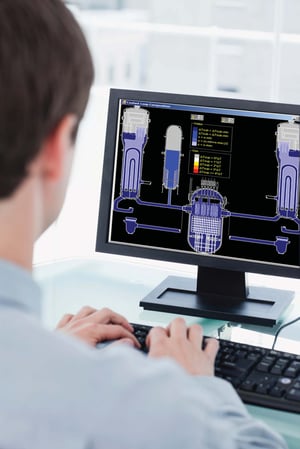Severe Accident Post Fukushima Engineering /MAAP5 Advanced Capabilities
..jpg?width=1778&name=BWR%20reactor%20similar%20to%20Fukushima%20Daiichi%20Unit%201%20(Aerial%20view%20of%20Fukushima%20Daiichi%20nuclear%20site%20in%20the%20background)..jpg) BWR reactor similar to Fukushima Daiichi Unit 1 (Aerial view of Fukushima Daiichi nuclear site in the background).
BWR reactor similar to Fukushima Daiichi Unit 1 (Aerial view of Fukushima Daiichi nuclear site in the background).
SAMG Update * MAAP5 Analysis * Level II Risk Analysis * Severe Accident Phenomena * Modular Accident Response System (MARS) Code for On-Line Accident Management * PRA Support * FLEX Equipment Evaluation* Power Coping Strategies for ELAP (Extended Loss of AC Power) Events
Intimately involved in the international response to the TMI-2, Chernobyl and Fukushima Daiichi accidents, Fauske & Associates, (FAI) was founded on expertise in the modeling, evaluation and mitigation of severe accidents at commercial nuclear power plants. FAI employs Probabilistic Risk Assessments, Modular Accident Analysis Programs, and other severe accident modeling techniques and tools to create comprehensive risk profiles, thereby mitigating the risk of future accidents.
FAI has collaborated with the nuclear industry in understanding and preparing for severe accidents at power reactors:
- In 1980, FAI contributed to the development of the foundation NSAC-1 report, the first analysis of the TMI-2 accident.
- In 1986, FAI was part of the U.S. mission to Vienna, Austria, where the Soviet Union provided their first technical briefing on the Chernobyl accident to the western European countries.
- In 2011, FAI helped man the “War Room” in Tokyo that was monitoring Fukushima Daiichi (1F) accident progression during the event and considering strategies for accident response and mitigation.
- In 2012, FAI joined the Japanese consortium that was tasked by government agency METI with developing technologies to understand accident progression and the subsequent end-state configuration of Units 1, 2, and 3 at the 1F site. This provided comprehension of key phenomena that are crucial to the fundamental understanding of 1F-specific progression.
“Due to its multiple reactor involvement and its occurrence within a conventional Western-style power reactor design, Fukushima Daiichi is a watershed event that has implications for the entire world-wide power reactor fleet, states James Burelbach, PhD, Director of Systems Modeling, FAI. "FAI’s 30+ years of intensive study and accomplishment in the field has culminated in our industry-leading efforts revealing fundamental lessons from Daiichi. These tractable, pragmatic lessons are an immediate benefit to plant Operations and Technical Support Committee (TSC) personnel, tasked with executing the Severe Accident Management Guidelines (SAMGs). Now, they can fulfill their mission with a much advanced expectation of plant response, informed by the Daiichi experience.”
FAI utilizes Probabilistic Risk Assessments (PRAs) and accompanying engineering calculations to quantify the risk profile. This determines the probability and potential severity of beyond-design-basis phenomena occurring in a nuclear power plant. FAI has supported Level I and Level II PRA analyses for many plants, dating back to the original individual plant examination (IPE) studies. Also, FAI has developed or enhanced software and methodologies for evaluating severe accident progression.
 |
| Engineer using MAAP graphical interface |
FAI was the original developer of the Modular Accident Analysis Program (MAAP), which is now an Electric Power Research Institute (EPRI) owned and licensed computer software. MAAP is a fast-running computer code that simulates the response of light water and heavy water moderated nuclear power plants for both current and Advanced Light Water Reactor (ALWR) designs. It can simulate Loss-Of-Coolant Accident (LOCA) and non-LOCA transients for PRA applications as well as severe accident sequences, including actions taken as part of the Severe Accident Management Guidelines (SAMGs). Originally developed by FAI as part of the Industry Degraded Core Rulemaking (IDCOR) program, there are now several parallel versions of MAAP for BWRs, PWRs, CANDU designs, FUGEN design and the Russian VVER PWR design. FAI continues to support EPRI in MAAP development, and we collaborate with users to meet their particular needs for model customization and PRA applications, including success criteria, timing of operator actions, and room heat-up, as well as SAMG development, full-scope simulators, and automated sensitivity studies.
FAI supports utilities/vendors in a collaborative way for all severe accident issues, including hydrogen, source term, equipment survivability, and atmospheric dispersion and dose. FAI has unique experience developed in part through performance of a number of key experiments to expand the understanding of severe accidents related to:
- Direct containment heating
- Drywell shell thermal interaction with core debris (Liner Melt-through potential)
- External cooling of core debris in the Reactor Pressure Vessel (RPV) lower plenum.
- Internal (“in-vessel”) cooling of core debris in the RPV lower plenum.
- Lower plenum penetration response to thermal attack by core debris
- Concentric tube cooling
- Core debris jet thermal attack on adjacent tube pairs
Stay up to date on the latest in severe accident modeling, testing and solutions, and other process safety news by subscribing to our blog below.

